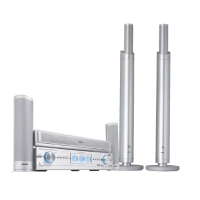Alignments
EN 131LX9000R 8.
We have to translate the decimal number to the next 5
hexadecimal numbers:
Example: 130156 (decimal) = 1FC6C (hex)
5. Program new digital board via nucleus 410 Therefore we
use the 10 hexadecimal numbers we calculated above:
example:
DD:> 410 10D7A1FC6C
41000:
Test OK @
The set has now its original unique number
8.4 Adjustment DVIO 1.8 PCB
This adjustment sets the free running frequency of the VCO of
the audio PLL. It should be carried out after replacement of IC
7604.
1. Disconnect DVD+RW set from the mains.
2. Plug DVIO1.8 board via edge-connector onto Digital Board
(DVIO board is vertically oriented, so that both sides of the
PCB are accessible for measurements).
3. Connect DVD+RW set to the mains.
4. Turn DVD+RW set on and select any video input source
except the DV input.
5. Check the signal at test point F611 with an oscilloscope.
The signal should be 5V digital with 50% duty-cycle.
6. Measure the frequency of the signal at test point F610 and
adjust the potentiometer 3605 to get a frequency of
12.288MHz ±50kHz (after removing the screwdriver from
the potentiometer).
6a. In case the frequency can not be increased sufficiently,
replace capacitor 2618 by NP0-type capacitor with
18pF. Adjust afterwards again the frequency with the
potentiometer.
6b. In case the frequency can not be decreased
sufficiently, add (3pF-10pF) trim-capacitor in parallel to
capacitor 2618 or replace capacitor 2618 by NP0-type
capacitor with 27pF.Adjust afterwards again the
frequency with the potentiometer (and/or trim-
capacitor).
7. Switch DVD+RW set to Stand-by mode.
8. Disconnect the DVD+RW set from the mains.
9. Plug DVIO1.8 board directly (without edge connector) onto
Digital Board.
10. Connect DVD+RW set to the mains.
11. Connect a DV-source that transmits DV-video data with
audio to the DVD+RW set.
12. Turn DVD+RW set on, select DV input, and switch
DVD+RW set appropriately to output the decoded signal.
Audio should be output without distortion.

